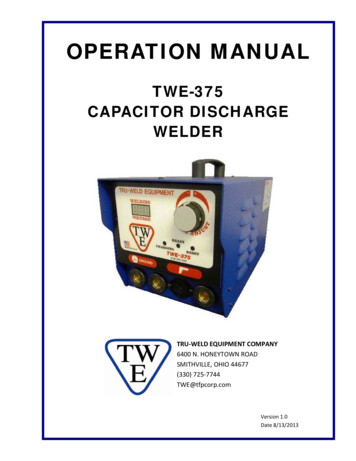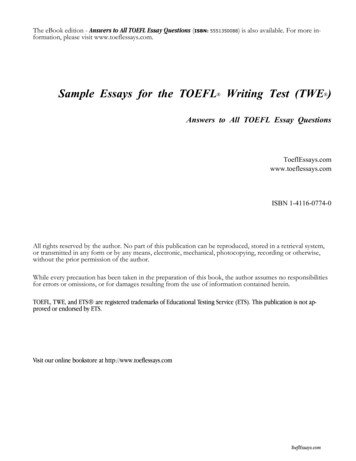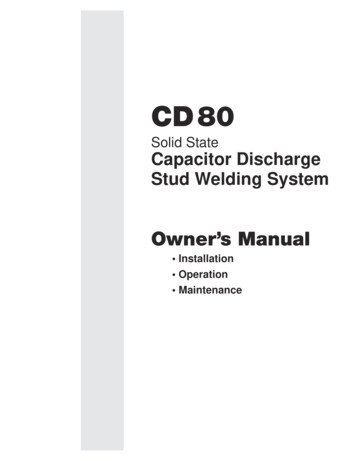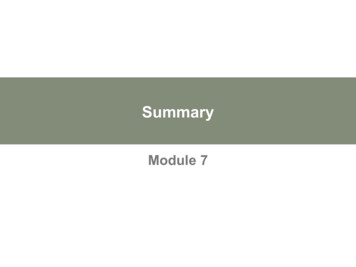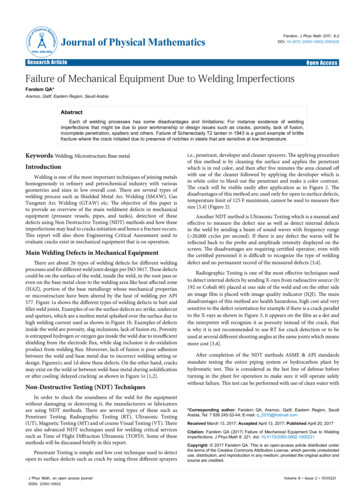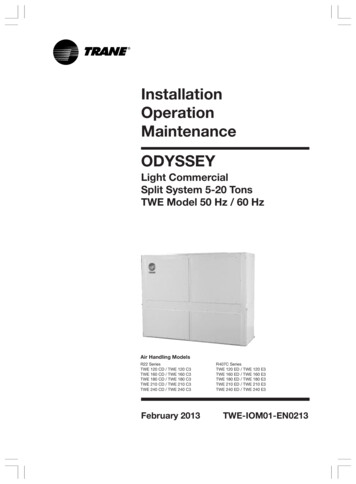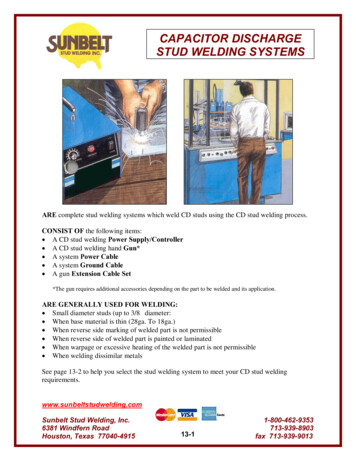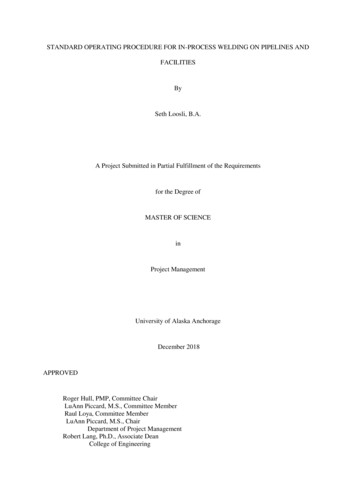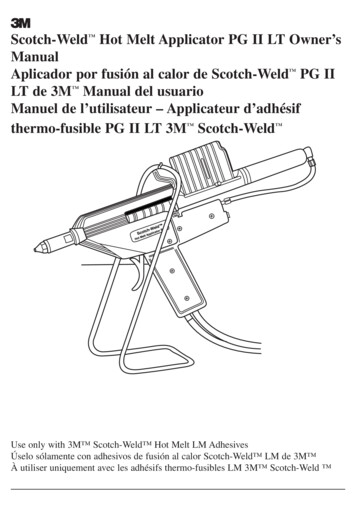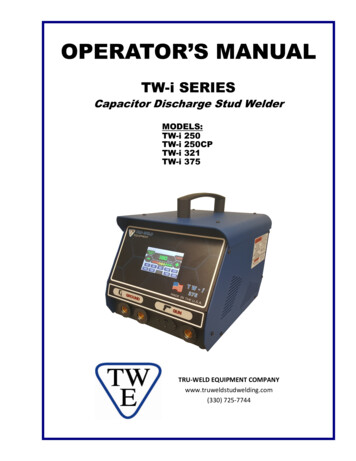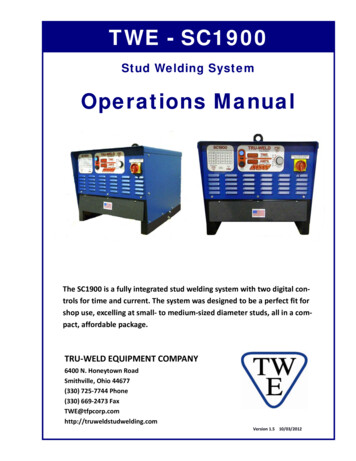
Transcription
TWE - SC1900Stud Welding SystemOperations ManualThe SC1900 is a fully integrated stud welding system with two digital con‐trols for time and current. The system was designed to be a perfect fit forshop use, excelling at small‐ to medium‐sized diameter studs, all in a com‐pact, affordable package.TRU‐WELD EQUIPMENT COMPANY6400 N. Honeytown RoadSmithville, Ohio 44677(330) 725‐7744 Phone(330) 669‐2473 sion 1.5 10/03/2012
TRU‐WELD EQUIPMENT LIMITED WARRANTYAll goods produced by Truweld Equipment shall be warranted against defects including workmanship and components. No other war‐ranties whether expressed, verbal, or implied will apply. Warranties only apply to the original equipment purchaser.Warranty claims will be limited to either repair or replacement of the defective materials by Truweld Equipment. At the option of Tru‐weld Equipment the location of where the warranty evaluation and repairs are made will be determined. All warranty claim items re‐turned to Truweld Equipment will be at the customer’s expense. At the option of Truweld Equipment the defect will either be repairedor replaced. Notice must be provided to Truweld Equipment of a warranty defect within 30 days that the defect or failure is incurred.Warranties are not transferable.This warranty does not apply for equipment which is used improperly in any fashion including but not exclusive to the following:Equipment which has been modifiedEquipment which has not been installed properlyEquipment which has been used for purposes other than which it had been designedEquipment which has not been properly maintainedEquipment which was continued to be used after a defect had been foundEquipment which was damaged in any wayTruweld Equipment will never be liable for consequential damages, loss, or expense occurring directly or indirectly from the use of theequipment covered in this warranty.All cables, cable sets and connectors are not warranted.Two (2) year warranty period from date of purchaseTWE250 Power SupplySC1900 Power SupplyTWE321 Power SupplySC1950 Power SupplyTWE375 Power SupplySC2400 Power SupplySC900 Power SupplySC2402 Power SupplySC1400 Power SupplySC2420 Power SupplySC1450 Power SupplySC3400 Power SupplySC1600 Power SupplySC3402 Power SupplySC1650 Power SupplyOne (1) year warranty period from date of purchaseTWESPC Power SuppliesTWP‐2Power SupplyNinety Day (90) warranty period from date of purchase(Excluding cables and connectors)TWE70000 HD Arc stud gunTWE18500 MD Arc stud gunTWE19000 LD Arc stud gunTWEG CD stud gunTWEHDG Heavy Duty CD stud gun2
Table of ContentsSectionDescriptionPage1.0Cover11.1Product Warranty22.0Table of Contents33.0Company Profile and Product Information44.0Safety Precautions4.1Safety Precautions ‐ Symbols and Description54.2Safety Precautions ‐ Electric Shock64.3Safety Precautions ‐ Welding Sparks75.0Product Specifications86.0SC1900 Setup and Installation6.1SC1900 Setup and Installation ‐ Initial Steps6.2SC1900 Setup and Installation ‐ Power Diagrams106.3SC1900 Setup and Installation ‐ Primary Power116.5SC1900 Setup and Installation ‐ Ground Cable Connections126.6SC1900 Setup and Installation ‐ Control Cable Connections137.0SC1900 Operations ‐ Stud Gun Setup7.1Stud Gun Setup ‐ Initial Steps147.2Stud Gun Setup ‐ Lift Adjustment157.3Stud Gun Setup ‐ Plunge Adjustment167.4Stud Gun Setup ‐ Cable Connections178.0SC1900 Operations ‐ Settings8.1SC1900 Operations ‐ Unit Power/Diagnostic Lights188.2SC1900 Operations ‐ Setting Time and Current198.3SC1900 Operations ‐ Setting Job Counter209.0SC1900 Operations ‐ Welding9.1Step by Step219.2Tips and Suggestions229.3Weld Inspection and g ‐ Chart A2610.2Troubleshooting ‐ Chart B2711.0Parts and Accessories28924, 253
Company and Product InformationCompany ProfileTru‐Weld Stud Welding has been making weld studs since 1959, and since 1970 we have been pro‐ducing our own line of high‐quality stud welding equipment. Tru‐Weld is located in Medina, Ohio andhas product and equipment distributors across the nation. Tru‐Weld Equipment Company (TWE) of‐fers a full line of Drawn‐Arc and Capacitor Discharge (CD) stud welding equipment, replacement parts,and accessories.Our experienced Management and Staff is committed to provide the utmost in quality and service inevery step of our production, while remaining competitive in the marketplace. It is our goal to meetour customer's needs more effectively than our competitors through a process of continuous qualityimprovement. Our long‐standing relationship with our customers' and suppliers' is our key to contin‐ued success and growth. If we can be of any further assistance to you and your company, please do nothesitate to contact us.Product InformationThe SC1900 is a fully integrated stud welding system with two digital controls for time and current.The system was designed to be a perfect fit for shop use, excelling at small‐ to medium‐sized diame‐ter studs, all in a compact, affordable package.Features: Smooth arc curve targeted for small to medium sized diameter studs Enhanced Duty Cycle production requirements Capable of up to 100 feet of 4/0 welding cable accommodates a large variety of work station lay‐outs Stepless time and current control allow for infinite settings for fine‐tuning the welding output Stud Job Counter that can be reset for every jobComplete system Includes:1800 Amp power supply, TWE17000 Heavy Duty stud gun, 35 feet of 4/0 combo cable and 25 feet of4/0 ground cable.4
Stud Welding Safety PrecautionsSafety is everyone’s responsibility. TRU‐WELD designs every machine with safety in mind, and asafe work environment depends largely on you.Do not install, operate, or repair this equipment without carefully reading this manual and observ‐ing all of the safety precautions mentioned. If there is a question, ask your supervisor!Safety SymbolsEvery effort has been made to protect trained operators from injury or unnecessary risk. Certainsymbols are used throughout this manual to call attention to safety‐related information and in‐struction. The safety symbols in this manual have these meanings:This symbol indicates Dangerous Situations. When this symbol is used in this manual,death or serious bodily harm is possible or probable if the corresponding preventativemeasures are not taken. Operators must take caution in the method and manner ofhandling or using the machine when this symbol is displayed.Safety PrecautionsDo not install, operate, or repair the SC1900 welding equipment without reading this manual andall safety precautions stated within!This machine was designed and built with operator safety in mind, but safety begins with you!Every effort has been made to protect the trained operator from injury. Please become familiarwith the information in this manual to minimize the risk of shock or injury.STUD WELDING CAN BE HAZARDOUS. ALWAYS PROTECT YOURSELF AND OTHERSFROM POSSIBLE INJURY OR DEATH. KEEP CHILDREN AWAY.Operators who have a pacemaker should consult with their physician before operating stud weld‐ing equipment.FUMES and OXYGEN DEPLETION Only weld in areas or rooms where adequate ventilation of weld gases is possible and wherethere is not fire, smoke or explosion hazards.When working in a confined space always have trained support personnel nearby.Welding fumes and gases can displace air and lower the oxygen level causing injury or death. Besure the breathing air is safe.Do not weld in locations near degreasing, cleaning, or spraying operations. The heat and rays ofthe arcs can react with vapors to form highly toxic and irritating gases.Do not weld on coated metals, such as galvanized, lead, or cadmium plated steel. The coatingmust be removed from the area to be welded. Coatings and metals containing above elementscan generate toxic fumes when heated to welding temperature.5
Stud Welding Safety PrecautionsELECTRIC SHOCKElectric shock can injure or kill!Precautionary measures must be taken to provide maximum protection against electri‐cal shock. Do not touch live or energized electrical parts or store metallic objects near power.Ground the work or metal to be welded to a good electrical (earth) ground.Do not leave an energized machine unattended.Never work in wet clothing, gloves or footwear.Insulate yourself from work and ground using dry insulation. Make certain the insulation islarge enough to cover your full area of physical contact with work and ground.Inspect all system components, protective equipment, cables, connectors and gas lines priorto operating equipment. Never use cables that are longer than necessary.When testing a live unit, use the one‐hand method. Do not put both hands inside of the unit.Keep one hand free.Disconnect input power conductors from de‐energized supply line before moving a weldingpower source.Always be sure the work cable makes a good electrical connection with the metal beingwelded. The connection should be as close as possible to the area being welded.Turn OFF welding power source before servicing unless the procedure specifically requires anenergized unit. Never touch the energized stud or gun before discharging the stud to ground. Never use the power source to provide heat for thawing frozen pipes.ARC RAYS and EYE PROTECTIONArc rays can injure eyes and burn skin.Arc flashes are painful. Use a shield with the proper filter and cover plates to protect your eyes from sparks and therays of the arc when welding or while observing open arc welding. Use protective clothing specifically intended for work with welding equipment. It should bemade of durable flame‐resistant material to provide ample protection from the arc rays. Protect other nearby workers with suitable, non‐flammable screening. Caution other workersnot to watch the arc nor expose themselves to the arc rays or to hot spatter or metal.6
Stud Welding Safety PrecautionsWELDING SPARKSHeat from flames and arcs can start fires. Hot slag or sparks can also cause fires andexplosions.Remove all combustible materials from the work area or cover these materials with a protective non‐flammable tarp.Combustible materials include wood, fabrics, sawdust, liquid and gas fuels, solvents, paints and coatings, paper, etc.Hot sparks or hot metal can fall through cracks or crevices in floors or wall openings and cause a hidden smolderingfire. Make certain that such openings are protected from hot sparks and metal.ELECTRIC and MAGNETIC FIELDSElectric current flowing through any conductor causes localized Electro‐Magnetic Fields (EMF). Welding and cuttingcurrent creates EMF around welding cables and welding machines. Operators having pacemakers should consult their physician before welding. EMF may interfere with some typeof pacemakers.Exposure to EMF may have other health effects, which are unknown.Operators should use the following procedures to minimize exposure to EMF:Route the work cables together. Secure them with electrical tape when possible.Never coil the work cable around any part of your body.Do not place your body between the work cables. Route cables on the same side of your body.Connect the work cable to the work piece as close as possible to the area being welded.Keep welding power source and cables as far away from your body as possible.Electromagnetic fields can irrevocable erase magnetic data carriers (computer memory, credit cards, security IDcards or data storage diskettes).Electromagnetic fields may magnetize and damage watches or similar digital devices.PROTECT YOURSELF and OTHERS!Some welding, cutting, and gouging processes are noisy and require ear protection. The arc, like the sun,emits ultraviolet (UV) and other radiation and may injure skin and eyes. Hot metal can cause burns.Training in the proper use of welding processes and equipment is essential to prevent accidents. Always wear safety glasses with side shields in any work area. In conjunction with eye protection, welding hel‐mets or face shields are also required.Use a face shield fitted with the correct filter cover plates to protect your eyes, face, neck, and ears from sparksand rays of the arc when operating or observing operations. Warn bystanders not to watch the arc and not toexpose themselves to the rays of the electric arc or hot metal.Wear flameproof type gloves, heavy long‐sleeve shirt, cuff less trousers, and a welding helmet or cap for hair pro‐tection, to protect against arc rays and hot sparks or hot metal. A flameproof apron may also be desirable as pro‐tection against radiated heat and sparks.Hot sparks or metal can lodge in rolled up sleeves, trouser cuffs, or pockets. Sleeves and collars should be keptbuttoned, and open pockets eliminated from the front of clothing.7
SC1900 Product SpecificationsWeld Range1/4” to 7/8”Consistent welding regardless of stud diameter.Duty Cycle1/4” thru 3/8”Unlimited1/2”22 to 24 per minute5/8”9 to 10 per minute3/4”4 to 5 per minute7/8”3 to 4 per minuteHeight22” (559mm)Width25” (635mm)Length30” (762mm)Weight390 Lbs. (177kg)DimensionsInput VoltagesFusing Requirements230 / 460 / 575 VAC 3 Phase 60Hz(Slow acting)230 / 120Amps460 / 60 Amps575 / 50 AmpsFeatures Smooth arc curve targeted for small to medium sized diameter studs Enhanced Duty Cycle production requirements Capable of up to 100 feet of 4/0 welding cable accommodates a large variety of work stationlayouts Stepless time and current control allow for infinite settings for fine‐tuning the welding output Stud Job Counter that can be reset for every job On‐Demand Fan that cycles on and off when needed.** Specifications are subject to change without prior notification.8
SC1900 Setup and InstallationInitial StepsOnly qualified personnel should perform this installation. Turn the input power off at the disconnect switch or fuse box before working on the welder. Do not touch electrically hot parts.This section provides detailed instructions for the proper installation of the TWE SC1900. It isrecommended that these instructions be followed carefully to allow for the best possible operat‐ing environment.Handling and Unpacking the WelderImmediately upon receipt of the welder, inspect the shipment for any damage and notify thecarrier of such damage before accepting delivery. Then inspect welder for damage which mayhave occurred in transit. After removing the components from the shipping container(s), checkthe container for any loose parts. Remove all packing materials. Visually check all air passages ofpower source for any packing materials that may obstruct airflow through the welder. If theequipment is not being installed immediately, store it in a clean, dry, well‐ventilated area until in‐stallation.Selecting a LocationThe location of the power source should be carefully selected to ensure satisfactory and depend‐able service. Choose a location relatively close to a properly fused source of electrical power. Usecare against toppling over if the machine is placed on a tilted surface or plane. It is important thatthe machine be located in an open area where air can circulate freely through the front and rearopenings. If space is at a premium, leave at least 1 foot (300 mm) of clearance between the rearof the power source and wall or other obstruction.Electrical Input RequirementThe welding power source is designed to be operated from three‐phase, 60Hertz, AC power sup‐ply. Consult your local electrical utility if you have any questions on the electrical system at thepresent installation site. The SC1900 should be operated from a separate, fused or circuit‐breakerprotected circuit.9
SC1900 Setup and InstallationPower Connection DiagramsElectrical Input RequirementThe SC1900 is equipped with an Input Voltage Jumper Block so you can operate the unit from dif‐ferent line voltages depending on your requirements. These settings should be checked to see ifthey are properly positioned for the voltage being used. Cross the terminals on the Jumper Block with the jumper (Figure 1) and tighten down the holddown nuts. Use the schematic below for the jumper setting to suit your line voltage requirementJumpersFigure 1 ‐ Jumper BlockFigure 2 ‐ FusesThe welder is supplied with spare fuses, lo‐cated below the jumper block.10
SC1900 Setup and InstallationPreparing the Unit for Primary PowerOnly qualified personnel should perform this installation. Turn the input power off at the disconnect switch or fuse box before working on the welder. Do not touch electrically hot parts.Remove the top cover of the SC1900. All of the connections that will need to be made are accessi‐ble with the top cover removed.Primary Power Cable Route the Primary Power Cable through the Power Inlet Hole in the top left corner on thebackside of the welder. Connect the power leads (Black, White, Red) to the L1, L2, and L3 connectors as shown in Fig‐ure 1. Firmly tighten screws that hold the power leads in place. Attach the ground wire (Green) to the ground lug of as shown in Figure 1. Once the Primary Power Cable is connected, tighten Power Cable Clamp on the back of thewelder, holding the power cable firmly in place (see Figure 2). Allow enough play in cable sothat the cable is free from any obstructions and does not lay across jumper board.Figure 1Figure 2Power Inlet(in back of unit)Ground ConnectionPower Connections11
SC1900 Setup and InstallationGround Cable Connections The SC1900 is equipped with one ground cable connection located in the front of the welder(lift access panel). Tighten ground cable to welder and secure other end to work surface using the Ground CableClamp (see Figure 2).Figure 1 ‐ Front of SC1900Ground connectionAccess PanelFigure 2 ‐ Ground CableGround Cable Lug (to welder)Ground Cable C‐Clamp (to work surface)12
SC1900 Setup and InstallationWeld Cable Connections The SC1900 is equipped with two weld cable connections located in the front of the welder(lift access panel). One end of the cable assembly connects directly to the SC1900 and the other end connects tothe cabling from the weld gun. The welder end will have a cable lug on the 4/0 Weld Cableand a male 4‐pole plug on the Control Cable. Tighten weld cable lug to welder . Plug Control Cable plug into port on bottom front of welder (lift access panel). The ControlCable has a male 4‐pole connector on one end that plugs into the port.Figure 1 ‐ Front of SC1900Access PanelControl Cable ConnectionWeld Cable ConnectionAfter the cables are connected to the welder, it is time to configure your weld gun for itsspecific job. Once the gun is configured and set up properly, the gun cables will connect tothe weld cables. For the SC1900, the weld cable ends that connects to the Heavy‐DutyTWE17000 Stud Gun will be a female Control Cable Plug and a female camlock connector.13
Stud Gun SetupStud Gun SetupEach stud welding application requires that the stud gun be set up properly for the correct studand ferrule arrangement. Select the correct style and size of chuck for the stud to be welded and attach it to the studgun. Select the proper length leg assemblies for the length of the stud. Select the proper foot piece best suited for your application. Select the grip to fit the ferrule which is provided with the stud to be welded.After all of the proper accessories have been mounted on the stud gun place the stud in the chuckand begin the alignment of the accessories. Make certain that a sufficient amount of the stud is inserted in the chuck so that the stud isheld firmly. Attach the ferrule to the ferrule grip. Plunge setting; move the leg, foot and ferrule assembly so that the stud protrudes beyond theferrule (1/8” for studs 1/2" and under in diameter 3/16” for studs up through 7/8” and 1/4”for 1” diameter studs). Position this assembly so that the stud moves freely through the ferrule when you slide theshaft of the stud gun back and forth.14
Stud Gun SetupLiftSet the lift when all of the accessories and stud have been properly set on the stud gun, prior towelding. Plug the control connector of the stud gun directly into the stud welder (do not attach theweld cable). Turn on the stud welder and actuate the trigger of the stud gun with the stud and fer‐rule in place. Note the retraction of the shaft of the stud gun. This is designated as the Lift.The lift setting should be about 3/32” for general welding applications and studs ranging in diameterthrough 3/4" this adjustment should be suitable. For larger diameter studs and select applicationsthe lift should be adjusted to approximately 1/8”.Adjusting the lift: Remove the back cap of the stud gun. Loosen the two socket set screws around the periphery of the lift adjustment screw. To increase lift rotate the lift adjustment screw counter clockwise and to decrease lift rotateclockwise. With each turn check the lift by actuating the stud gun until the desired lift is achieved. Tighten the socket set screws to hold the lift adjustment screw in place to secure the selectedsetting. Replace the back cap of the stud gun.Set ScrewRear Coil YokeLift Adjusting ScrewGun Body15
Stud Gun SetupFree Travel AdjustmentThis adjustment can be used to control the force with which the stud is plunged into the moltenweld pool by moving the engagement point of when the shaft of the stud gun engages the damp‐ener.Rotating the dampener cover counter clockwise increases the amount of free travel.Dampener CoverTWE17000 Heavy‐Duty Stud Gun16
Stud Gun SetupAttaching the stud gun to start welding Select the gun, control cable, and weld cable that is recommended for the specific type ofwelder and the job. Attach stud gun to weld and control cable extension. Actuate the stud gun without placing it on the surface to be welded to assure that the con‐nection through the control cable is correct to complete the circuit and actuate the stud gun. Make sure welder is set up properly to begin the welding process. Place the selected stud into the chuck and attach the ferrule to the ferrule grip. Place stud onto surface to be welded and press stud gun down until ferrule is flush with thewelding surface. Trigger the gun and hold in place until cycle is completed. Pull gun assembly straight up off of the welded stud. Do not depress trigger when removing gun from stud. Remove the ferrule by breaking it off and inspect the weld. Make proper adjustments as needed.Figure 1 ‐ TWE17000 Heavy‐Duty Stud GunWeld CableControl Cable17
SC1900 Operations ‐ SettingsSC1900 Power Switch/Power OnThe power switch for the SC1900 is located on the right front ofthe welder’s control panel. The rotary switch is off in the verticalposition (“0”). The switch turned to the horizontal position (“I”),turns the unit on.When the welder is turned on, the digital display will go through aself‐diagnostic check. This takes approximately 3 to 5 seconds,and then the digital display will show the last time and currentsetting.This denotes that the unit is ready to go.When connected to the welder, the stud gun will actuate 3 times,indicating that there is a good connection.SC1900 Diagnostic LightsOn the Control Panel, located below the digital display, is a row of diagnostic lights for thewelder.OUTPUT ‐ When the stud gun is triggered, this light comes on to indicate that the OCV is presentat the output terminals.TRIGGER ‐ When the stud gun is triggered, this light comes on to indicate that the trigger circuit isfunctioning properly, and that the welding unit is receiving feedback from the stud gun.POWER ‐ When this light is lit, it indicates that there is an error.TEMP ‐ When this light is lit, it indicates that either the main transformer or weld bridge hasreached maximum temperature and that the unit will not function until it is cooled.REMOTE ‐ This function is not currently in use.Diagnostic Lights18
SC1900 Operations ‐ SettingsSetting Welding Controls ‐ Time and CurrentThe time and current controls are located on the front of the welder. The controls consist of aTime Button, Current Button, Adjustment Dial, and a Fine/Coarse Switch. The digital display willindicate the settings chosen during setup.Time ButtonFine/Coarse SwitchCurrent ButtonDigital DisplaysAdjustment Dial When setting time or current, depress and hold down appropriate button, and turn Adjust‐ment Dial clockwise or counter‐clockwise to the correct setting on the digital display. Use the Fine/Coarse Switch for setting the appropriate time or current ‐ this will toggle be‐tween 10’s or 100’s of amps and 10th’s and 100th’s of a second . There is a Chart (see below) of approximate settings for full‐base diameter studs located tothe left of the Controls.DIA INCHTIME SECAMPS DCDIA DECDIA 1800.87522.2219
SC1900 Operations ‐ SettingsWeld Counter and Weld Counter ResetThe SC1900 is equipped with different counters to display the number of times the unit has drawnan arc or the stud gun has been actuated.Perpetual Weld Counter (Non‐resettable) ‐ This is a running total of every time an arc is drawn onthe machine. This is programmed from the factory and can not be reset.Perpetual Gun Counter (Non‐resettable) ‐ This is a running total of every time the stud gun isactuated whether an arc was drawn or not.Job Counter (Resettable) ‐ This is a running total of the number of welds since the counter waslast reset. To view the job counter, set the Fine/Coarse Switch to the Fine position. Each weld willbe recorded on the Current digital display. If the switch is in the Coarse position, the weld will stillbe counted, but will not be displayed. You can also view the Job Counter total by depressing theAdjustment Dial while the switch is in the Coarse position.To Reset the Job Counter;1. Turn off unit.2. Depress and hold down Time and Current buttons.3. Turn on machine.4. Keep holding down buttons until OUTPUT light flashes then release the buttons.5. Job Counter will now be set at 0.6. Weld count will now register on Current digital display.Press down and holdJob Counter will display here20
SC1900 Operations ‐ WeldingStud Welding ‐ Step by StepThe weld gun is positioned over the base material and the main gun springis partially compressed. Hold gun perpendicular to work surface and holdferrule firmly against the surface.The trigger is pressed and the stud lifts off the base, drawing an arc. The arcmelts the end of the weld stud and the base material below. The arc shield(ferrule) concentrates the heat below the weld stud and contains the mol‐ten metal within the weld zone. Do not move weld gun during weld.The main spring plunges the weld stud down into the molten pool of metalin the base material. The cycle is completed in less than a second and theresulting weld bond develops the full strength of the fastener in the weldzone. Allow metal to cool and withdraw gun from the stud, pulling the gunstraight up off of the stud.The weld gun is withdrawn from the weld stud leaving and the ferrule. Theferrule is broken away and discarded. Visually inspect weld.*** Note ‐ when determining finished length required for the particular application, keep in mindthe reduction in length (burn‐off) from stud welding operations. TRU‐WELD stud lengths are al‐ways given before weld.Diameter of StudReduction in Length1/4” thru 1/2”1/8”5/8” thru 7/8”3/16”1” and over1/4”21
SC1900 Operations ‐ WeldingStud Welding ‐ Helpful Hints and Suggestions Keep weld studs and ferrules clean and dry. Set the time for the appropriate weld base diameter (see chart on page 19). Set the amperage for the appropriate weld base diameter (see chart on page 19). Make sure the negative polarity is to the weld stud gun and ensure a good, clean ground con‐nection. Align accessories so they are centered and adjust legs so that 3/16” to 1/4” of the stud pro‐trudes beyond the ferrule. Make sure work surface is relatively clean so impurities do not affect weld. Test the welds at the beginning of each shift or change in stud. Bend two studs 30 degrees af‐ter cooling (AWS Bend Test). Check burn off (1/8” – 3/16”), color (silver blue and shiny), and weld fillet (360 degree). Visually inspect all welds.To ensure satisfactory welds, bend test a minimum of one stud out of every one‐hundred, bystriking stud with a hammer and bending the stud 15o from its original axis.22
SC1900 Operations ‐ WeldingVisual Weld Inspection and AdjustmentsGood WeldAfter shooting the stud, break away ferrule and visually inspect the weld.The collar should be smooth and even around the entire stud.Partial WeldThis is when the collar does not extend around the entire perimeter of thebase of the stud. This normally occurs when the weld power is set too low.Irregular WeldThis is when the collar forms a bumpy or jagged collar around the base ofthe weld stud. This normally occurs when the weld time is set too high.Porous Weld CollarThis usually occurs from the oxidation of the weld pool resulting from theweld time being set too long and/or the current being too low. Reduce thecurrent and/or reduce the weld time to correct.Weld Collar Off‐CenterThis is when the collar is heavy or thick on one half of the base of the weldstud. The stud may also be tilted. This usually results from movement fromthe gun during the weld process or the gun not being flush or perpendicularto the base material during welding.23
SC1900 TroubleshootingProblemPossible CauseFixUnit will not turn on.No power.1.2.3.4.5.6.Fan does not run when unit isturned on.This is normal.The fan will cycle on when the main bridge has reachednominal operating temperature. Ambient temperature of theweld site should also be taken in consideration.Fan runs continuously (doesnot cycle on/off)Thermostat circuitA fault in the thermostatic circuit will cause the fan to runcontinuously. Call your TWE Rep for repairs.Unit turns
Tru‐Weld Stud Welding has been making weld studs since 1959, and since 1970 we have been pro‐ ducing our own line of high‐quality stud welding equipment. Tru‐Weld is located in Medina, Ohio and has product and equipment distributors across the nation. Tru‐Weld Equipment Company (TWE) of‐
